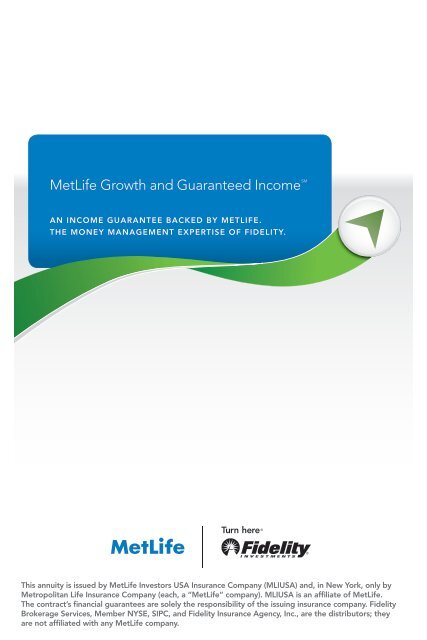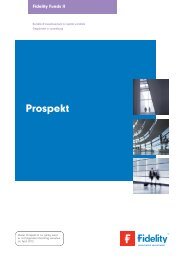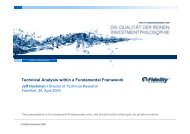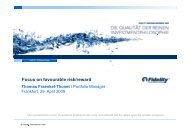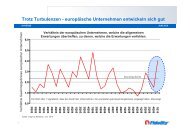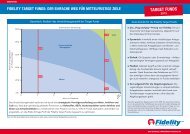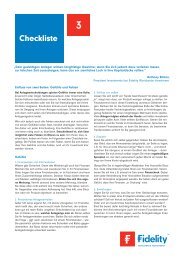MetLife Growth And Guaranteed Income - Fidelity
MetLife Growth And Guaranteed Income - Fidelity
MetLife Growth And Guaranteed Income - Fidelity
You also want an ePaper? Increase the reach of your titles
YUMPU automatically turns print PDFs into web optimized ePapers that Google loves.
<strong>MetLife</strong> <strong>Growth</strong> and <strong>Guaranteed</strong> <strong>Income</strong> SM<br />
An income guArAntee bAcked by metLife.<br />
the money mAnAgement expertise of fideLity.<br />
this annuity is issued by metLife investors usA insurance company (mLiusA) and, in new york, only by<br />
metropolitan Life insurance company (each, a “metLife” company). mLiusA is an affiliate of metLife.<br />
the contract’s financial guarantees are solely the responsibility of the issuing insurance company. fidelity<br />
brokerage services, member nyse, sipc, and fidelity insurance Agency, inc., are the distributors; they<br />
are not affiliated with any metLife company.
<strong>MetLife</strong> <strong>Growth</strong> and <strong>Guaranteed</strong> <strong>Income</strong>:<br />
helping you meet the challenges of<br />
retirement — in any market<br />
Market volatility makes retirement planning<br />
a challenge for many investors. Despite the<br />
market’s historical long-term upward trend,<br />
volatility, as illustrated in the chart below, has<br />
1800<br />
1600<br />
1400<br />
1200<br />
1000<br />
800<br />
600<br />
400<br />
200<br />
0<br />
Jan 91<br />
Jan 92<br />
Jan 93<br />
Jan 94<br />
Jan 95<br />
Jan 96<br />
Jan 97<br />
Jan 98<br />
Jan 99<br />
Source: <strong>Fidelity</strong> Investments, December 2010.<br />
past performance is no guarantee of future results.<br />
Jan 00<br />
influenced investor behavior and ultimately the<br />
performance of retirement portfolios. Where do<br />
you think the market will go from here?<br />
market volatility in the s&p 500 ® index<br />
(January 1, 1991, to December 31, 2010)<br />
3/24/00<br />
49% decline<br />
Jan 01<br />
Jan 02<br />
10/9/02<br />
Jan 03<br />
Jan 04<br />
101% increase<br />
Jan 05<br />
Jan 06<br />
Jan 07<br />
10/9/07<br />
Jan 08<br />
3/9/09<br />
Want to see how it works? Just open here.<br />
* Quantitative analysis of investor behavior (QAIB) uses data from the Investment Company Institute (ICI), Standard & Poor’s, and Barclays Capital<br />
Index Products to compare mutual fund investor returns to an appropriate set of benchmarks. Covering the period from January 1, 1991, to<br />
December 31, 2010, the study utilizes mutual fund sales, redemptions and exchanges each month as the measure of investor behavior. These<br />
behaviors reflect the “average investor.” Based on this behavior, the analysis calculates the “average investor return” for various periods. These<br />
results are then compared to the returns of respective indexes. QAIB calculates investor returns as the change in assets, after excluding sales,<br />
redemptions, and exchanges. This method of calculation captures realized and unrealized capital gains, dividends, interest, trading costs, sales<br />
charges, fees, expenses, and any other costs. After calculating investor returns in dollar terms annualized return rate is calculated as the uniform<br />
rate that can be compounded annually for the period under consideration to produce the investor return dollars. The Standard & Poor’s 500<br />
Composite Index is an unmanaged index of 500 common stocks generally representative of the U.S. stock market. The S&P 500 ® Index and S&P<br />
are registered trademarks of The McGraw-Hill Companies, Inc., and are licensed for use by <strong>Fidelity</strong> Distributors Corporation and its affiliates. The<br />
Barclays Capital Aggregate Bond Index is an unmanaged market value–weighted index representing securities that are SEC registered, taxable,<br />
and dollar denominated. This index covers the U.S. investment-grade fixed-rate bond market, with index components for a combination of the<br />
Barclays Capital government and corporate securities, mortgage-backed pass-through securities, and asset-backed securities.<br />
performance of an index is not illustrative of any particular investment. it is not possible to invest directly in an index.<br />
57% decline<br />
Jan 09<br />
Jan 10
Retirement Readiness<br />
As illustrated below, investors, on average, generally underperform the market in part because<br />
they may not have the discipline to hold their investments through the inevitable ups and downs.<br />
If your performance falls short of your expectations, will you be able to generate enough income<br />
in retirement to support your lifestyle?<br />
Annualized Return (%)<br />
performance of the markets vs. an average mutual fund investor’s performance<br />
(January 1, 1991, to December 31, 2010)<br />
10.0%<br />
9.0%<br />
8.0%<br />
7.0%<br />
6.0%<br />
5.0%<br />
4.0%<br />
3.0%<br />
2.0%<br />
1.0%<br />
0.0%<br />
9.14%<br />
S&P 500 ®<br />
Index<br />
3.83%<br />
Average<br />
Equity<br />
Fund<br />
Investor<br />
Get the confidence you need<br />
8.76%<br />
Hypothetical<br />
Balanced<br />
Investment †<br />
Key benefits<br />
2.56%<br />
Average<br />
Asset<br />
Allocation<br />
Fund<br />
Investor<br />
<strong>Guaranteed</strong> 1 income<br />
<strong>Growth</strong> potential<br />
Access to assets<br />
6.89%<br />
Barclays<br />
Capital<br />
Aggregate<br />
Bond Index<br />
1.01%<br />
Average<br />
Fixed<br />
<strong>Income</strong><br />
Fund<br />
Investor<br />
Source: Quantitative Analysis of Investor Behavior* (QAIB), 2011, DALBAR, Inc. www.dalbar.com<br />
† Source: FMRCo. Based on the performance of an investment weighted 60% to the S&P 500 Index and 40% to the<br />
Barclays Capital Aggregate Bond Index. It is not possible to invest directly in an index.<br />
past performance is no guarantee of future results.<br />
<strong>MetLife</strong> <strong>Growth</strong> and <strong>Guaranteed</strong><br />
<strong>Income</strong>SM , a deferred variable annuity<br />
that provides a guaranteed1 lifetime<br />
income stream, combines the strength<br />
of two industry leaders — an income<br />
guarantee1 backed by <strong>MetLife</strong> and<br />
the money management expertise<br />
of <strong>Fidelity</strong>.<br />
Provides lifetime retirement income through<br />
withdrawals for you (or for you and your<br />
spouse).<br />
Your income has the potential to increase in<br />
good markets.<br />
If your situation changes, you have access to<br />
your assets should you ever need them. 2<br />
1 guarantees apply to certain insurance and annuity products (not securities, variable or investment advisory<br />
products) and are subject to product terms, exclusions and limitations and the insurer’s claims-paying ability<br />
and financial strength.
Here’s How It Works:<br />
You get protection in declining markets<br />
<strong>MetLife</strong> <strong>Growth</strong> and <strong>Guaranteed</strong> <strong>Income</strong> helps protect your lifestyle when<br />
your account value declines due to poor market performance.<br />
1 You<br />
make an investment and<br />
establish (lock) a benefit base.<br />
benefit base 3<br />
Account Value<br />
Lifetime income<br />
0 1 2 3 4 5<br />
contract anniversaries (years)<br />
Account Value<br />
2 Why<br />
is your benefit base important?<br />
The amount of guaranteed annual income<br />
you are able to withdraw is calculated as a<br />
fixed percentage of the benefit base.<br />
Benefit Base Benefit Base Lock<br />
2 Excess withdrawals (which happen when you withdraw an amount greater than your guaranteed annual income payment<br />
or guaranteed withdrawal benefit (GWB) amount in a contract year) and any withdrawal prior to age 59½ may significantly<br />
reduce both the guaranteed withdrawal benefit amount and, if taken during the first five contract years, may be subject to a<br />
2% surrender fee. Withdrawals of taxable amounts are subject to ordinary income tax, and, if made before age 59½, may be<br />
subject to a 10% IRS penalty.<br />
this hypothetical example is for illustrative purposes only and is not intended to predict or project investment results.<br />
your results will vary.<br />
3 The<br />
net result? If your account value<br />
declines or becomes fully depleted<br />
due to poor market performance, there<br />
will be no impact to your income. 2<br />
Lifetime <strong>Income</strong>
<strong>And</strong> growth potential in rising markets<br />
<strong>MetLife</strong> <strong>Growth</strong> and <strong>Guaranteed</strong> <strong>Income</strong> potentially helps improve your<br />
lifestyle if your account value grows.<br />
1 You<br />
make an investment and<br />
establish (lock) a benefit base.<br />
2 You<br />
automatically lock a higher benefit base<br />
if your account value reaches a new high on<br />
your contract anniversary (until the oldest<br />
annuitant turns 85).<br />
4 Why<br />
benefit base 3<br />
Account Value<br />
is your benefit base important?<br />
The amount of guaranteed annual income<br />
you are able to withdraw is calculated as a<br />
fixed percentage of the benefit base.<br />
Lifetime income<br />
3 While the guarantee associated with the benefit base does not protect your contract (account) value, it does protect your income<br />
amount. Benefit base, also known as <strong>Guaranteed</strong> Withdrawal Benefit Value (GWB Value) in the prospectus, will be compared to contract<br />
value annually and increased when the contract value exceeds the benefit base on anniversary dates prior to the oldest annuitant<br />
reaching age 85. After age 85, customers will no longer be eligible for potential benefit base increases. Withdrawals will reduce the<br />
contract value and death benefit and may impact whether your income payments will increase even if your contract value is increasing.<br />
this hypothetical example is for illustrative purposes only and is not intended to predict or project investment results.<br />
your results will vary.<br />
3 A<br />
higher benefit base will increase<br />
the guaranteed annual income you<br />
are able to withdraw, providing the<br />
opportunity to help improve your<br />
lifestyle. 3<br />
0 1 2 3 4 5<br />
contract anniversaries (years)<br />
Account Value Benefit Base Benefit Base Lock Lifetime <strong>Income</strong>
A lifetime of income — guaranteed<br />
Once you decide to begin withdrawing income from <strong>MetLife</strong> <strong>Growth</strong> and <strong>Guaranteed</strong> <strong>Income</strong>, your<br />
guaranteed annual income4 is determined by a simple formula, and is recalculated annually and<br />
automatically (on your contract anniversary date) until the oldest annuitant reaches age 85.<br />
Benefit base<br />
2, 5 value<br />
(GWB Value)<br />
Initial Investment<br />
(adjusted for any withdrawals<br />
you have already received) 6<br />
×<br />
Your income<br />
percentage<br />
(withdrawal percentage) =<br />
Once you make<br />
a withdrawal after<br />
age 59½, this<br />
percentage is set<br />
and never changes<br />
If you pass away when... Your beneficiaries receive 6<br />
Your account<br />
value is higher...<br />
Your account<br />
value is lower...<br />
Age of the youngest annuitant<br />
when you withdraw your first<br />
income payment<br />
<strong>And</strong> protection for your beneficiaries<br />
The full account value<br />
A choice of:<br />
•<br />
•<br />
Your guaranteed<br />
annual income<br />
(guaranteed withdrawal benefit)<br />
The remaining account<br />
value<br />
Corresponding<br />
income<br />
percentage<br />
59½–64 4%<br />
65 –75 5%<br />
76+ 6%<br />
With <strong>MetLife</strong> <strong>Growth</strong> and <strong>Guaranteed</strong> <strong>Income</strong>, your beneficiaries are guaranteed, at minimum, every<br />
dollar you’ve invested (adjusted for any withdrawals you have already received) 6 payable in installments.<br />
They also have the option of receiving the entire account value in a lump sum.<br />
Your original investment<br />
(adjusted for any withdrawals<br />
you have already received)<br />
over time, in regular installments<br />
4 <strong>Guaranteed</strong> annual income is not available until the youngest annuitant reaches age 59½.<br />
5 At issue, this value is equal to your initial investment. It can be revised higher on subsequent contract anniversaries if certain conditions<br />
are met (until the oldest annuitant reaches age 85).<br />
6<br />
During the accumulation phase, beneficiaries may elect to receive the contract value or a return of purchase<br />
payment, adjusted for withdrawals, payable in periodic payments that annually do not exceed your guaranteed<br />
annual income. Example shown pertains to a single annuitant contract. For joint annuitants, the death benefit will be<br />
payable to your beneficiaries upon the last surviving annuitant’s death. See the prospectus for details.
Quick facts and features<br />
Investment option<br />
Annual annuity charge<br />
Annuity charge<br />
calculation method<br />
Other costs<br />
• <strong>Fidelity</strong> VIP FundsManager ® 60% Portfolio 7<br />
• An actively managed fund of funds<br />
• Targets an allocation of 60% stocks, 35% bonds, and 5% in short-term investments<br />
• Annual annuity charge of 1.90% (for single life coverage) or 2.05%<br />
(for joint life coverage)<br />
- This charge covers the cost of the lifetime withdrawal guarantee, the death<br />
benefit, and the contract’s other insurance and administrative charges<br />
• The annual annuity charge is calculated as a percentage of the account<br />
(contract) value 8<br />
• A 2% surrender fee may be applied to withdrawals made before age 59½ or in<br />
excess of the guaranteed withdrawal benefit in years 1 to 5 of the contract<br />
• Investment option expense ratio of 0.85% (as of 4/30/2011)<br />
• No annual maintenance fees or initial sales charges<br />
Issue ages • All annuitants must be between the ages of 50 and 85 at issue<br />
Purchase minimum • $50,000<br />
Funding methods<br />
<strong>Income</strong> payment<br />
options<br />
• Fund your purchase with:<br />
- Retirement savings from existing tax-deferred accounts, such as traditional IRA<br />
accounts or employer-sponsored accounts [such as a 401(k) plan] 9<br />
- A tax-free exchange from an existing annuity 10 or with after-tax assets (no<br />
commingling allowed)<br />
• Single lifetime income<br />
• Joint lifetime income (available in both qualified and non-qualified contracts)<br />
• <strong>Income</strong> payments (withdrawals) can be systematic upon request<br />
go to fidelity.com/incomeplus or call 800.544.2442.<br />
7 the performance of the fidelity Vip fundsmanager 60% portfolio depends on that of its underlying<br />
fidelity and fidelity Vip funds. fidelity Vip fundsmanager 60% is subject to the volatility of the<br />
financial markets in the u.s. and abroad, and may be subject to the additional risks associated with<br />
investing in high-yield, commodity-linked, small-cap, and foreign securities. the portfolio is managed<br />
by strategic Advisers, ® inc., a subsidiary of fmr LLc.<br />
8 The charge is deducted as part of the daily calculation of the value of the accumulation units. We assess a daily annuity charge<br />
equal, on an annual basis, to 1.90% (for a single annuitant) or 2.05% (for joint annuitants) of the average daily net asset value of each<br />
investment option.<br />
9 If you are buying a variable annuity to fund a qualified retirement plan or IRA, you should do so for the variable annuity’s features and<br />
benefits other than tax deferral. In such cases, tax deferral is not an additional benefit.<br />
10 before exchanging, check with your current provider to see if it will assess a surrender charge,<br />
and also consider the existing benefits and features you may lose in an exchange, which may be of<br />
particular importance in poor market conditions.
efore investing, consider the investment objectives, risks, charges, and expenses of the variable annuity<br />
and its investment options. call or write to fidelity or visit fidelity.com for a free prospectus and, if available,<br />
summary prospectus containing this information. please read the prospectus and consider this information<br />
carefully before investing. product availability and features may vary by state. please refer to the contract<br />
prospectus for more complete details regarding the living and death benefits.<br />
the contract value is subject to market fluctuations and investment risk so that, when withdrawn, it may be<br />
worth more or less than its original value.<br />
<strong>MetLife</strong> <strong>Growth</strong> and <strong>Guaranteed</strong> <strong>Income</strong> annuity (Policy Form Series No. 8800 (10/09)) is issued by <strong>MetLife</strong> Investors USA Insurance Company<br />
(MLIUSA), 5 Park Plaza, Suite 1900, Irvine, CA 92614 and, in New York (Policy Form Series No. 6800 (10/09)), only by Metropolitan Life Insurance<br />
Company, 200 Park Avenue, New York, NY 10166 (each, a “<strong>MetLife</strong>” company). MLIUSA and Metropolitan Life Insurance company are affiliates.<br />
The contract’s financial guarantees are solely the responsibility of the issuing insurance company. <strong>Fidelity</strong> Brokerage Services, Member NYSE,<br />
SIPC, and <strong>Fidelity</strong> Insurance Agency, Inc., are the distributors; they are not affiliated with any <strong>MetLife</strong> company.<br />
© 2012 FMR LLC. All rights reserved.<br />
L0212237245[0313]<br />
604217.1.0<br />
Want more information?<br />
Go to <strong>Fidelity</strong>.com/incomeplus<br />
or call 800.544.2442.<br />
MGGI-BRO-0212<br />
1.937451.100


